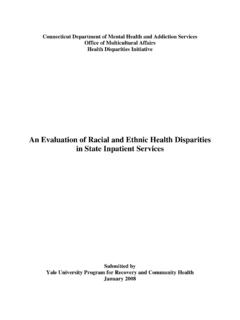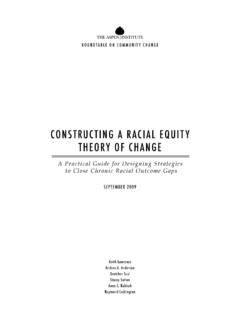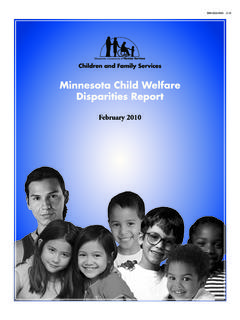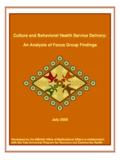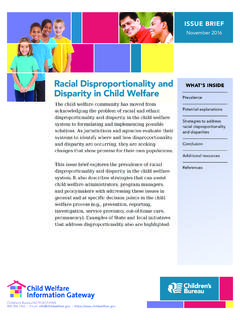Transcription of Analysis of Racial Disparities in the New York Police ...
1 Analysis of Racial Disparities in the New york Police Department s Stop, Question, and Frisk PracticesGreg RidgewaySupported by the New york city Police FoundationA R A N D I N F R A S T R U C T U R E , S A F E T Y, A N D E N V I R O N M E N T P R O G R A MSafety and Justice PRE-PUBLICATION COPY. This document has been peer-reveiwed and edited but not R AND Corporation is a nonprofit research organization providing objective Analysis and effective solutions that address the challenges facing the public and private sectors around the world. R AND s publications do not necessarily ref lect the opinions of its research clients and is a registered trademark. Copyright 2007 R AND CorporationAll rights reserved.
2 No part of this book may be reproduced in any form by any electronic or mechanical means (including photocopying, recording, or information storage and retrieval) without permission in writing from R 2007 by the R AND Corporation1776 Main Street, Box 2138, Santa Monica, CA 90407-21381200 South Hayes Street, Arlington, VA 22202-50504570 Fifth Avenue, Suite 600, Pittsburgh, PA 15213-2665R AND URL: order R AND documents or to obtain additional information, contact Distribution Services: Telephone: (310) 451-7002; Fax: (310) 451-6915; Email: research described in this report was supported by the New york city Police Foundation and was conducted under the auspices of the Center on Quality Policing (CQP), part of the Safety and Justice Program within R AND Infrastructure, Safety, and Environment (ISE).
3 IiiPrefaceIn February 2007, the New york city Police Department (NYPD) released statistics that indi-cated that more than a half-million pedestrians had been stopped on suspicion of a crime in New york city in 2006. Almost 90 percent of the stops involved nonwhites. The department immediately faced questions regarding its stop, question, and frisk (SQF) patterns and prac-tices. The department contacted the R AND Center on Quality Policing (CQP) to conduct an objective Analysis of data collected in street encounters between the Police and the public, and the New york city Police Foundation funded a project that began later that report documents the methods and findings from the R AND researchers Analysis of NYPD s SQF data.
4 This report should be of interest to NYPD executives and command staff and New york city policymakers and community members. This report may also prove useful to residents and officials in other jurisdictions where similar practices are under consideration and similar issues are being confronted. Related R AND work that may be of interest to readers of this report includes the following: Police -Community Relations in Cincinnati (Riley et al., 2005) Police -Community Relations in Cincinnati: Year Two Evaluation Report (Ridgeway et al., 2006)Testing for Racial Profiling in Traffic Stops From Behind a Veil of Darkness (Grogger and Ridgeway, 2006)Assessing the Effect of Race Bias in Post-Traffic Stop Outcomes Using Propensity Scores (Ridge-way, 2006)Race and the Decision to Seek the Death Penalty in Federal Cases (Klein, Berk, and Hick-man, 2006) Police Personnel Challenges After September 11: Anticipating Expanded Duties and a Chang-ing Labor Pool (Raymond et al.)
5 , 2005)Assessing Racial Profiling More Credibly (Ridgeway and Riley, 2004).The RAND Center on Quality PolicingThis research was conducted under the auspices of the Center on Quality Policing (CQP), part of the Safety and Justice Program within R AND Infrastructure, Safety, and Environment (ISE). The center s mission is to help guide the efforts of Police agencies to improve the effi-ciency, effectiveness, and fairness of their operations. The center s research and Analysis focus on force planning ( , recruitment, retention, training), performance measurement, cost- iv Analysis of Racial Disparities in the New york city Police Department s Stop, Question, and Frisk Practiceseffective best practices, and use of technology, as well as issues in Police -community relations.
6 The mission of R AND Infrastructure, Safety, and Environment is to improve the develop-ment, operation, use, and protection of society s essential physical assets and natural resources and to enhance the related social assets of safety and security of individuals in transit and in their workplaces and communities. Safety and Justice Program research addresses occupa-tional safety, transportation safety, food safety, and public safety including violence, policing, corrections, substance abuse, and public or comments about this report should be sent to the project leader, Greg Ridge-way Information is available online about the Safety and Justice Program ( ) and the CQP ( ). Inquiries about the CQP should be made to its associate director, Jeremy Wilson Inquiries about research projects should be sent to the fol-lowing address:Andrew Morral, DirectorSafety and Justice Program, ISER AND Corporation1200 South Hayes StreetArlington, VA 22202-5050703-413-1100.
7 IiiFigures ..viiTables ..ixSummary ..xiAcknowledgments ..xviiAbbreviations ..xixChAPTer OneIntroduction: review of the new york city Police Department s Stop, Question, and Frisk PolIcy and Practices ..1 Introduction ..1 Levels of Police -Initiated Contacts Between Police and Citizens in New york State ..2 Training of Officers on Stop, Question, and Frisk policies ..3 ChAPTer TwODescription of the 2006 Stop, Question, and Frisk Data ..7 ChAPTer Threeexternal Benchmarking for the Decision to Stop ..13 Summary ..13 Introduction ..13 Residential Census ..14 Arrests in 2005 ..16 Crime-Suspect Descriptions ..18 Conclusions ..19 ChAPTer FOurInternal Benchmarking for the Decision to Stop ..21 Summary ..21 Introduction ..21 Methods.
8 22 Results ..26 Conclusions ..30 ChAPTer FIveAnalysis of Post-Stop Outcomes ..31vi Analysis of Racial Disparities in the New york city Police Department s Stop, Question, and Frisk PracticesSummary ..31 Introduction ..31 Methods ..32 Results ..35 Analysis of Hit Rates ..40 Conclusions ..42 ChAPTer SIxConclusions and recommendations ..43 Conclusions ..43 Recommendations ..44 APPenDIxeSA. Details of Statistical Models used in the external-Benchmark Analysis ..47B. Details of Propensity-Score weighting ..49C. estimating False Discovery rates ..51D. unified Form 250: Stop, Question, and Frisk report worksheet ..53references ..57viiFigures Stops per 1,000 People (estimated daytime population) ..7 Seven Most Common Suspected Crimes Reported as Reason for the Stop, by Race.
9 8 Comparison of Stop Rates to Seven External Benchmarks ..18 Maps of the Sample Officer s Stops and of Similarly Situated Stops Made by Other Officers ..23 Distribution of 2,756 Officer-Level Analyses ..27ixTables Frequency of Suspected Crimes and Recovery Rates of Contraband for Frisked or Searched Suspects, by Race ..11 Results of a Residential-Census Benchmark Analysis ..14 Construction of an Internal Benchmark for a Sample Officer ..24 Comparison of the Percentage of Stops for a Particular Suspected Crime for the Sample Officer and the Officer s Internal Benchmark ..25 Internal-Benchmark Analysis for Stop Rates of Black Suspects ..28 Internal-Benchmark Analysis for Stop Rates of Hispanic Suspects.
10 29 Internal-Benchmark Analysis for Stop Rates of Hispanic Suspects, Excluding Stops Based on Suspect Descriptions or Calls for Service ..29 Distribution of Stop Features, by Race, for Manhattan South ..33 Comparison of Stop Outcomes for White Pedestrians with Those for Nonwhite Pedestrians Who Are Similarly Situated to the Stopped White Pedestrians ..36 Comparison of Stop Outcomes for Black Pedestrians with Those for Pedestrians of Other Races Who Are Similarly Situated to the Stopped Black Pedestrians ..38 Hypothetical Example of a Hit-Rate Analysis ..41 Frisked or Searched Suspects Found Having Contraband or Weapons ..42xiSummaryIn 2006, the New york city Police Department (NYPD) was involved in a half-million encoun-ters with pedestrians who were stopped because of suspected criminal involvement.











